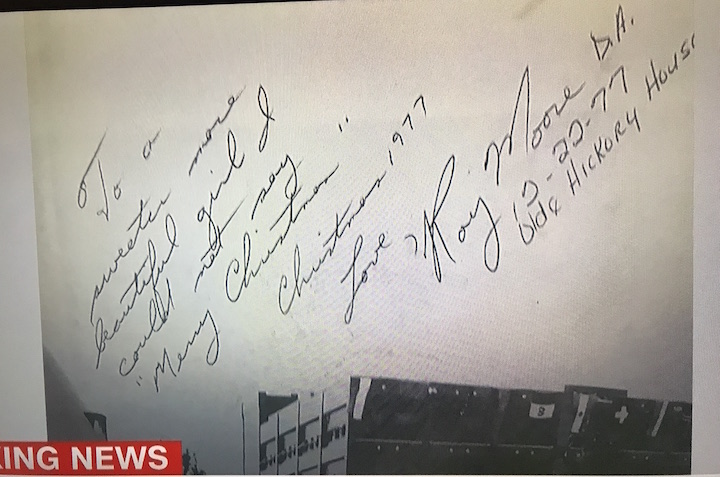Locals Were Troubled by Roy Moore’s Interactions with Teen Girls at the Gadsden Mall
Is this the handwriting of a predator of underage girls. According to the 5th woman to accuse the US senator of inappropriate actions now coming forward 40 years later.
While sexual misconduct cannot always be spotted in someone’s personality, are their any indicators here than this 30 year old District attorney acted on his impulses to date and sexually harass under age girls?
I see a ton of anger, sarcasm, enthusiasm, and domineering nature. I also see a self-conscious M hump which indicates his fear of rejection.

oy Moore, the Republican Senate candidate and former chief justice of the Alabama Supreme Court, was born in Gadsden, a small city flanked by Interstate 59 and the Coosa River, an hour northeast of Birmingham.
Gadsden is hilly, woodsy, blue-collar, and religious. “LEGAL OR NOT, SIN IS SIN,” a sign in front of a church announced yesterday. I saw it as I drove around, crisscrossing George Wallace Drive. I also saw Trump posters, Confederate flags, and dozens of signs for Doug Jones, the Democrat tied with Moore in recent Senate-race polls. Gadsden is the seat of Etowah County, which is a conservative place; Donald Trump received three times as many votes in the county as Hillary Clinton did. (Statewide, he received twice as many.) But I didn’t, in all my driving, see a single yard sign for Moore, the home-town son. Even the parking lot of the one mall in town had more bumper stickers for Luther Strange (four), Moore’s opponent in the Republican primary, than for Moore himself (one).
The Gadsden Mall opened in 1974. It has two department stores, Belk and Sears, one on each end. Between them, on Sunday night, I walked past Books-A-Million, Cellular Solutions, a Japanese steak house, Great American Cookies, Blacklight Mini-Golf, KnockerBall Gadsden, an eyebrow-styling kiosk, and a clothing store for young girls, called Justice. A diverse assortment of families wandered around the place, which felt trapped in time. Two young security guards made their rounds. “It gets rough in here on Saturday nights,” one of them told me, mentioning fighting, stealing, and gun-toting. “We still have an active ban list,” the other said, referencing a list of chronic rule-breakers not allowed on mall property. “But it doesn’t go back that far.”
He meant back to the early eighties, when Roy Moore was, many people say, a regular visitor to the mall. On Thursday, the Washington Post reported that, when Moore was a thirty-two-year-old assistant district attorney in Etowah County, he brought Leigh Corfman, who was fourteen years old at the time, to his home and sexually molested her. Three additional women told the Post that Moore had pursued them when they were in their teens and he was in his early thirties. (On Monday, another woman, Beverly Young Nelson, said that Moore assaulted her when she was sixteen years old. At a press conference, she held up a high-school yearbook that she said Moore signed before the alleged assault.) Two of the women say that they first met Moore at the Gadsden Mall, and the Post reports that several other women who used to work there remembered Moore’s frequent presence—“usually alone” and “well-dressed in slacks and a button-down shirt.”
This past weekend, I spoke or messaged with more than a dozen people—including a major political figure in the state—who told me that they had heard, over the years, that Moore had been banned from the mall because he repeatedly badgered teen-age girls. Some say that they heard this at the time, others in the years since. These people include five members of the local legal community, two cops who worked in the town, several people who hung out at the mall in the early eighties, and a number of former mall employees. (A request for comment from the Moore campaign was not answered.) Several of them asked that I leave their names out of this piece. The stories that they say they’ve heard for years have been swirling online in the days since the Post published its report. “Sources tell me Moore was actually banned from the Gadsden Mall and the YMCA for his inappropriate behavior of soliciting sex from young girls,” the independent Alabama journalist Glynn Wilson wrote on his Web site on Sunday. (Wilson declined to divulge his sources.) Teresa Jones, a deputy district attorney for Etowah County in the early eighties, told CNN last week that “it was common knowledge that Roy dated high-school girls.” Jones told me that she couldn’t confirm the alleged mall banning, but said, “It’s a rumor I’ve heard for years.”
Greg Legat, who is now fifty-nine and living in East Gadsden, was, from 1981 to 1985, an employee at the Record Bar, a store that was in the Gadsden Mall. By the early eighties, Legat told me, the mall was “the place to be. There were no empty stores. And lots of kids came around. Lots of teen-agers. You went there to see and be seen.” Legat met his wife, Jo Anne, there. She worked at a restaurant called Orange Bowl. Legat remembers that parents dropped their kids off at the mall, typically unchaperoned. Teens filled the place.
Legat says that he saw Moore there a few times, even though his understanding then was that he had already been banned. “It started around 1979, I think,” Legat said. “I know the ban was still in place when I got there.” Legat recalled a Gadsden police officer named J. D. Thomas, now retired, who worked security at the mall. “J. D. was a fixture there, when I was working at the store,” Legat said. “He really looked after the kids there. He was a good guy. J. D. told me, ‘If you see Roy, let me know. He’s banned from the mall.’ ” Legat recalled Thomas telling him, “If you see Moore here, tell me. I’ll take care of him.’ ” Legat said that his boss, Eddie Hill, also told him to look for Moore. A phone call to Hill’s number was not returned.
Reached by phone on Saturday, Thomas, who lives in the nearby town of Southside, declined to discuss the existence of a ban on Moore at the Gadsden Mall. “I don’t have anything to say about that,” he said. A former manager of the mall, who began working there in the late eighties, confirmed the existence of a ban list, but did not recall Moore being on the list during the manager’s tenure there. Barnes Boyle, who is eighty-six, also managed the mall, from 1981 to 1998. His wife, Brenda, told me that Moore was a longtime acquaintance of his—they went to the Y.M.C.A. together often—and that he planned to vote for him. The recent allegations against Moore, the Boyles thought, are likely liberal propaganda and, as Brenda put it, “a sign of the times.”
Jason Nelms, an I.T. worker who grew up in nearby Southside and now lives in Tennessee, regularly visited the Gadsden Mall as a teen-ager, in the early eighties. “It was a joke from one of the managers/assistant managers that they couldn’t keep an eye on their theater and an eye on the kids outside,” he explained to me via Facebook Messenger. “Us kids would congregate outside on the sidewalk near the theater after the mall closed on Friday and Saturday nights. Anyway, when asked why they had to keep an eye outside, they said that some older guy had been trying to pick up younger girls. They didn’t go beyond that but one of the concession workers whispered to us later that it was Roy Moore he was talking about.”
Gadsden’s current law-enforcement community could not confirm the existence of a mall ban on Moore. But two officers I spoke to this weekend, both of whom asked to remain unnamed, told me that they have long heard stories about Moore and the mall. “The general knowledge at the time when I moved here was that this guy is a lawyer cruising the mall for high-school dates,” one of the officers said. The legal age of consent in Alabama is sixteen, so it would not be illegal there for a man in his early thirties to date a girl who was, say, a senior in high school. But these officers, along with the other people I spoke to, said that Moore’s presence at the mall was regarded as a problem. “I was told by a girl who worked at the mall that he’d been run off from there, from a number of stores. Maybe not legally banned, but run off,” one officer told me. He also said, “I heard from one girl who had to tell the manager of a store at the mall to get Moore to leave her alone.”
The second officer went further. “A friend of mine told me he was banned from there,” he said. He added, “I actually voted for Moore. I liked him at one time. But I’m basically disgusted now, to be honest with you. Some of the things he’s said recently, I’ve changed my tune completely about this guy.” He went on, explaining why Moore no longer appeals to him. “When I heard what he said on ‘Hannity’ the other night,” he said, referring to an appearance Moore made on Sean Hannity’s radio show last Friday, “I almost stood straight up. The thing about how he’s never dated anybody without their mother’s permission, that appalled me. That made me want to throw up. Why would you need someone’s permission to date somebody? I’m probably gonna write in Luther Strange.”
Moore has mounted various defenses since the Post story appeared. Among these is his “special concern for the protection of young ladies,” as he put it to Hannity. The Fox News host pressed for specifics. “I don’t know Ms. Corfman from anybody,” Moore went on. “I never talked to her, never had any contact with her. Allegations of sexual misconduct with her are completely false. I believe they are politically motivated. I believe they are brought only to stop a very successful campaign, and that’s what they are doing. I’ve never known this woman.” When questioned about the other women cited in the Post story, he said that he couldn’t be expected to remember every woman he’d ever dated. “After my return from the military,” he said, “I dated a lot of young ladies.”
